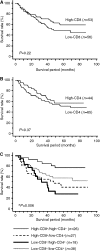Concurrent infiltration by CD8+ T cells and CD4+ T cells is a favourable prognostic factor in non-small-cell lung carcinoma
- PMID: 16421594
- PMCID: PMC2361103
- DOI: 10.1038/sj.bjc.6602934
Concurrent infiltration by CD8+ T cells and CD4+ T cells is a favourable prognostic factor in non-small-cell lung carcinoma
Abstract
The purpose of this study was to clarify the relationship between the number of tumour-infiltrating T lymphocytes and the clinicopathological features and clinical outcome in patients with non-small-cell lung cancer (NSCLC). Tissue specimens from 109 patients who underwent surgical resection for NSCLC were immunohistochemically analysed for CD4 and CD8 expression. Patients were classified into two groups according to whether their tumours exhibited a 'high' or 'low' level of CD8(+) or CD4(+) lymphocyte infiltration. Although the level of infiltration by CD8(+) T cells alone had no prognostic significance, the survival rate for patients with both 'high' CD8(+) and 'high' CD4(+) T-cell infiltration was significantly higher than that for the other groups (log-rank test, P=0.006). Multivariate analysis indicated that concomitant high CD8(+) and high CD4(+) T-cell infiltration was an independent favourable prognostic factor (P=0.0092). In conclusion, the presence of high levels of both CD8(+) T cells and CD4(+) T cells is a significant indicator of a better prognosis for patients with NSCLC, and cooperation between these cell populations may allow a significantly more potent antitumour response than either population alone.
Figures



References
-
- Cheng TY, Wu JT, Lin RH (1998) Induction of tumor-specific T cell response by cognating tumor cells with foreign antigen-primed Th cells. Int Immunol 10: 1397–1406 - PubMed
-
- Cho Y, Miyamoto M, Kato K, Fukunaga A, Shichinohe T, Kawarada Y, Hida Y, Oshikiri T, Kurokawa T, Suzuoki M, Nakakubo Y, Hiraoka K, Murakami S, Shinohara T, Itoh T, Okushiba S, Kondo S, Katoh H (2003) CD4+ and CD8+ T cells cooperate to improve prognosis of patients with esophageal squamous cell carcinoma. Cancer Res 63: 1555–1559 - PubMed
-
- Fiorentino DF, Zlotnik A, Mosmann TR, Howard M, O'Garra A (1991a) IL-10 inhibits cytokine production by activated macrophages. J Immunol 147: 3815–3822 - PubMed
-
- Fiorentino DF, Zlotnik A, Vieira P, Mosmann TR, Howard M, Moore KW, O'Garra A (1991b) IL-10 acts on the antigen-presenting cell to inhibit cytokine production by Th1 cells. J Immunol 146: 3444–3451 - PubMed
-
- Fukunaga A, Miyamoto M, Cho Y, Murakami S, Kawarada Y, Oshikiri T, Kato K, Kurokawa T, Suzuoki M, Nakakubo Y, Hiraoka K, Itoh T, Morikawa T, Okushiba S, Kondo S, Katoh H (2004) CD8+ tumor-infiltrating lymphocytes together with CD4+ tumor-infiltrating lymphocytes and dendritic cells improve the prognosis of patients with pancreatic adenocarcinoma. Pancreas 28: e26–31 - PubMed
Publication types
MeSH terms
LinkOut - more resources
Full Text Sources
Other Literature Sources
Medical
Research Materials

